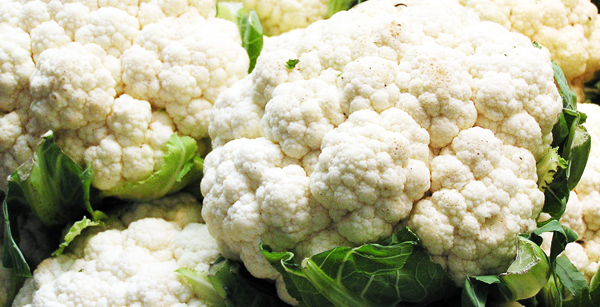Cauliflower – The Tree of Life
Written By: Geri Wohl, CNC
www.bettereatingcoach.com
How often have you walked right by those white cousins of broccoli not knowing what to do with them? Cauliflower may seem like the ugly stepsister of the cruciferous family, but in fact, it is a powerhouse of important nutrients for us to incorporate into our diets. Given the nutrients and potential health benefits, eating a serving of some type of cruciferous vegetable every day seems like an easy way to boost our health!
The cruciferous family includes broccoli, Brussels sprouts, cabbage and kale as well as cauliflower. Cauliflower originated in Asia Minor from wild cabbage, eventually reappearing in the Mediterranean region around 600 BC in its present form. Cauliflower typically has a curd, a tightly formed head of undeveloped flower buds attached to a central stalk. Green leaves protect the flowers from sunlight preventing chlorophyll formation. Chlorophyll is the pigment responsible for the green color of vegetables. Cauliflower is at its peak from December through March. The curd should be firm with a little give. Usually you’ll find white cauliflower, but it may also be green, orange or purple. The colored cauliflowers will possess more antioxidants than white ones. You’ll find that cauliflower has a slight smell of sulfur (more on that in a bit).
Cauliflower is very low in calories; one cup has only 26 calories! It is also low in fat and has no cholesterol. Important vitamins found in cauliflower include vitamin C with a daily value (DV) of 86%, vitamin K with a DV of 21%, folate with a DV of 15% and vitamin B6 with a DV of 10%. It also is a very good source of potassium, manganese and other B vitamins. In addition, one cup possesses about 5% of the RDA of dietary fiber.
There are four main body systems that the nutrients in cauliflower support.
- Detoxification: The liver is our primary organ performing detoxification. It has a two-step process to neutralize the toxic compounds that we encounter in our environment and the ones that are by-products of our metabolism. The antioxidants found in cauliflower augment our detox processes. For more about liver detox, see my article, “Wine and Wellness.” The sulfur found in cauliflower as well as the other vegetables in the cruciferous family also aids in the second liver detox phase. Every cell in the body requires sulfur. In fact, it is essential for the normal formation of certain proteins that are vital to connective tissues including cartilage, skin and hair. Sulfur provides our tissues with both strength and resiliency. Sulfur-containing foods are especially important to add in the winter as they support our joints, lungs and skin as we deal with the temperature changes and dry air.
- Antioxidant: Vitamin C not only supports the immune system, but is also an important antioxidant reducing the damage to our cells from free radicals. Vitamin C has been studied to reduce the length of colds and may help prevent cancer formation. Studies have linked cauliflower to the prevention of some cancers, particularly breast, colon, bladder, prostate and ovarian. A study published in the Journal of American Dietetic Association reported a link between consuming cruciferous vegetables and cancer protection. Sulforaphane, an anti-cancer phytonutrient, and indole-3-carbinol (I3C), a plant sterol, both found in cauliflower, show anti-estrogen activity; important if you have a genetic predisposition to breast cancer for instance. New research on sulforaphane is suggesting that it may also play a role in gene expression.
- Anti-inflammatory: Vitamin K is supportive by directly reducing the inflammatory response. The various sulfur compounds like I3C work together with vitamin K on a variety of systems. I3C actually influences our inflammatory response at the genetic level resulting in the prevention of the inflammatory response at the very early stages. These anti-inflammatory responses have effects on areas that we may not attribute to inflammation, such as the cardiovascular system. By acting to prevent inflammation, these compounds assist in keeping the blood vessels pliable, ensuring proper blood circulation.
- Digestion: The fiber in cauliflower aids in digestion by removing waste products and keeping the breakdown of our food moving through the digestive tract. Dietary fiber also assists in lowering our LDL cholesterol levels thus supporting our cardiovascular health. For more about fiber, see my article, “Not Just Dijon.” Not only does sulforaphane act as an antioxidant, but it also appears to protect the stomach lining and has been shown to protect against H. pylori in the stomach.
When purchasing cauliflower, look for heads that are free from blemishes. Cauliflower can be stored in the refrigerator for up to a week in a paper or plastic bag stem side down to prevent moisture development. When cooking cauliflower, sulfur compounds will be released. The longer the cooking time, the stronger the odor will be. To reduce the sulfur odor, cook for a shorter time. Cauliflower can be served raw, in soups or stews, steamed, sautéed or even as a substitute for mashed potatoes. To see my recipe for mashed cauliflower, go to my Late Fall Recipes page.
Note that cauliflower is part of the goitrogenic family. Those with thyroid conditions may want to consume cauliflower cooked to inactivate the goitrogens. Also, cauliflower contains purines so should be avoided by those with gout and kidney issues.
© Geri Wohl, CNC












